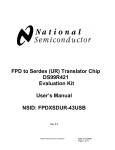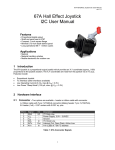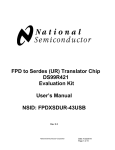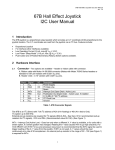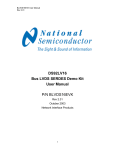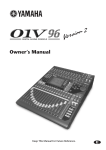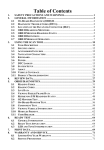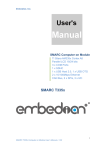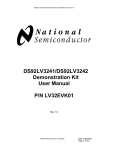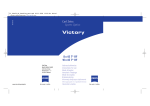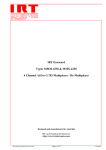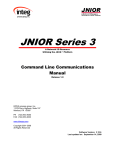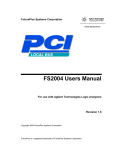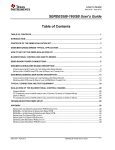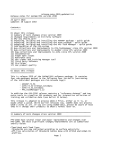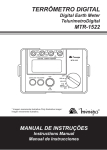Download EVM User`s Guide - Texas Instruments
Transcript
SERDES Evaluation Kit DS90UR241/124 USB Version 0.1 User Manual
SERDES Demonstration Kit
User Manual
Rev 0.2
NSID: SERDESUR-43USB
National Semiconductor Corporation
Date: 5/8/2008
Page 1 of 36
SERDES Evaluation Kit DS90UR241/124 USB Version 0.1 User Manual
Table of Contents
TABLE OF CONTENTS ........................................................................................................................................... 2
INTRODUCTION: ..................................................................................................................................................... 3
CONTENTS OF THE EVALUATION KIT:........................................................................................................... 4
SERDES TYPICAL APPLICATION:...................................................................................................................... 4
HOW TO SET UP THE EVALUATION KIT:........................................................................................................ 6
POWER CONNECTION: ......................................................................................................................................... 6
SERDES SERIALIZER BOARD DESCRIPTION: ................................................................................................ 7
CONFIGURATION SETTINGS FOR THE SERIALIZER BOARD ......................................................................................... 8
SERIALIZER LVCMOS AND LVDS PINOUT BY IDC CONNECTOR .......................................................................... 11
BOM (BILL OF MATERIALS) SERIALIZER PCB: ...................................................................................................... 12
RX SERDES DE-SERIALIZER BOARD: ............................................................................................................. 13
CONFIGURATION SETTINGS FOR THE DE-SERIALIZER BOARD ................................................................................. 14
OUTPUT MONITOR PINS FOR THE DE-SERIALIZER BOARD ...................................................................................... 15
DE-SERIALIZER LVDS PINOUT AND LVCMOS BY IDC CONNECTOR .................................................................... 17
BOM (BILL OF MATERIALS) DE-SERIALIZER PCB: ................................................................................................ 18
TYPICAL CONNECTION AND TEST EQUIPMENT........................................................................................ 19
TROUBLESHOOTING ........................................................................................................................................... 21
APPENDIX................................................................................................................................................................ 23
SERIALIZER (TX) PCB SCHEMATIC:............................................................................................................... 23
DE-SERIALIZER (RX) PCB SCHEMATIC:........................................................................................................ 27
SERIALIZER (TX) PCB LAYOUT: ...................................................................................................................... 31
SERIALIZER (TX) PCB STACKUP: .................................................................................................................... 34
DESERIALIZER (RX) PCB LAYOUT:................................................................................................................. 35
DESERIALIZER (RX) PCB STACKUP:............................................................................................................... 38
National Semiconductor Corporation
Date: 5/8/2008
Page 2 of 36
SERDES Evaluation Kit DS90UR241/124 USB Version 0.1 User Manual
Introduction:
National Semiconductor’s SERDES evaluation kit contains one (1) DS90UR241
Serializer (Tx) board, one (1) DS90UR124 De-serializer (Rx) board, and one (1) generic
two (2) meter USB 2.0 Hi-SPEED cable assembly. National is not recommending using
the USB 2.0 Hi-SPEED cable assembly but is provided in this kit as a generic solution
to show the robustness of the chipset.
Note: the demo boards are not for EMI testing. The demo boards were designed for
easy accessibility to device pins with tap points for monitoring or applying signals,
additional pads for termination, and multiple connector options.
The DS90UR241/124 chipset supports a variety of display applications. The single
LVDS interface is well-suited for any display system interface. Typical applications
include: navigation displays, automated teller machines (ATMs), POS, video cameras,
global positioning systems (GPS), portable equipment/instruments, factory automation,
etc.
The DS90UR241 and DS90UR124 can be used as a 24-bit general purpose LVDS
Serializer and De-serializer chipset designed to transmit data at clocks speeds ranging
from 5 to 43 MHz.
The DS90UR241 serializer board accepts LVCMOS input signals. The LVDS Serializer
converts the LVCMOS parallel lines into a single serialized LVDS data pair with an
embedded LVDS clock. The serial data stream toggles at 28 times the base clock rate.
With an input clock at 43 MHz, the transmission rate for the LVDS line is 1.204Gbps.
The DS90UR124 de-serializer board accepts the LVDS serialized data stream with
embedded clock and converts the data back into parallel LVCMOS signals and clock.
Note that NO reference clock is needed to prevent harmonic lock as with other devices
currently on the market.
Suggested equipment to evaluate the chipset, an LVCMOS signal source such as a
video generator or word generator or pulse generator and oscilloscope with a bandwidth
of at least 43 MHz will be needed.
The user needs to provide the proper LVCMOS/RGB inputs and LVCMOS/clock to the
serializer and also provide a proper interface from the de-serializer output to an LCD
panel or test equipment. The serializer and de-serializer boards can also be used to
evaluate device parameters. A cable conversion board or harness scramble may be
necessary depending on type of cable/connector interface used on the input to the
DS90UR241 and to the output of the DS90UR124.
Example of suggested display setup:
1) video generator with LVCMOS output
2) 6-bit LCD panel with a LVCMOS input interface.
National Semiconductor Corporation
Date: 5/8/2008
Page 3 of 36
SERDES Evaluation Kit DS90UR241/124 USB Version 0.1 User Manual
Contents of the Evaluation Kit:
1) One Serializer board with the DS90UR241
2) One De-serializer board with the DS90UR124
3) One 2-meter USB 2.0 Hi-SPEED cable assembly
4) Evaluation Kit Documentation (this manual)
5) DS90UR241/124 Datasheet
SERDES Typical Application:
Figure 1a. Typical SERDES Application (18-bit RGB Color)
Figure 1b. Typical SERDES System Diagram
National Semiconductor Corporation
Date: 5/8/2008
Page 4 of 36
SERDES Evaluation Kit DS90UR241/124 USB Version 0.1 User Manual
Figures 1a and 1b illustrate the use of the Chipset (Tx/Rx) in a Host to Flat Panel
Interface.
The chipsets support up to 18-bit color depth TFT LCD Panels.
Refer to the proper datasheet information on Chipsets (Tx/Rx) provided on each board
for more detailed information.
National Semiconductor Corporation
Date: 5/8/2008
Page 5 of 36
SERDES Evaluation Kit DS90UR241/124 USB Version 0.1 User Manual
How to set up the Evaluation Kit:
The PCB routing for the serializer input pins (DIN) have been laid out to accept
incoming LVCMOS signals from a 50-pin IDC connector. The TxOUT/RxIN (DOUT/RIN)
interface uses a USB connector/cable assembly (provided). The PCB routing for the Rx
output pins (ROUT) are accessed through a 50-pin IDC connector. Please follow these
steps to set up the evaluation kit for bench testing and performance measurements:
1) A two (2) meter USB connector/cable assembly has been included in the kit.
1
2
3
4
A
Connect 4-pin USB A
side of cable harness to the serializer board and
the other side 5-pin mini USB jack 1 2 3 4 MIN to the de-serializer board. This
completes the LVDS interface connection.
NOTE: The DS90C241 and DS90C124 are NOT USB compliant and should not
be plugged into a USB device nor should a USB device be plugged into the
demo boards.
2) Jumpers and switches have been configured at the factory; they should not require
any changes for immediate operation of the chipset. See text on Configuration
settings for more details. From the Video Decoder board, connect a flat cable (not
supplied) to the Serializer board and connect another flat cable (not supplied) from
the De-serializer board to the panel. Caution: The LVCMOS input levels should be
within the specified range for optimal performance, not to exceed the absolute
maximum rating of -0.3V to (VCC +0.3V).
Note: For 50 ohm LVCMOS input signal sources, add 50 ohm parallel termination
resistors R1-R25 on the DS90UR241 Serializer board and provide appropriate 3.3V
LVCMOS input signal levels into DIN[23:0] and TCLK.
3) Power for the Tx and Rx boards must be supplied externally through Power Jack
(VDD). Grounds for both boards are connected through Power Jack (VSS) (see
section below).
Power Connection:
The serializer and de-serializer boards must be powered by supplying power externally
through J4 (VDD) and J5 (VSS) on serializer Board and J4 (VDD) and J5 (VSS) on deserializer board. Note +4V is the absolute MAXIMUM voltage (not operating voltage)
that should ever be applied to the SERDES serializer (DS90UR241) or de-serializer
(DS90UR124) VDD terminal. Damage to the device(s) can result if the voltage
maximum is exceeded.
National Semiconductor Corporation
Date: 5/8/2008
Page 6 of 36
SERDES Evaluation Kit DS90UR241/124 USB Version 0.1 User Manual
SERDES Serializer Board Description:
The 50-pin IDC connector J1 accepts 24 bits of LVCMOS RGB data (DIN0-DIN23)
along with the clock input (TCLK).
The SERDES serializer board is powered externally from the J4 (VDD) and J5 (VSS)
connectors shown below. For the serializer to be operational, the Power Down (S1TPWDNB) and Data Enable (S1-DEN) switches on S1 must be set HIGH. Rising or
falling edge reference clock is also selected on S1-TRFB: HIGH (rising) or LOW
(falling). FPD_LINKII is an AC coupled LVDS (series 0.1µF capacitors on each side of
the LVDS serializer outputs and de-serializer inputs). JP1 and JP2 are configured from
the factory to be shorted to VSS; these are the unused power wires in the cable
harness.
The USB connector P2 (on the backside of the board) provides the interface connection
to the LVDS signals to the de-serializer board.
f J4, J5
Note:
VDD and VSS MUST
be applied externally
from here.
e VR1, JP3
h JP1, JP2
Note:
Connect cable
(USB A side)
to P2 on BACKSIDE.
g
J1
g
d
g
S1
g
c P2 (BACKSIDE)
c P1 (TOPSIDE)
(UNSTUFFED)
c LVDS OUTPUTS
d LVCMOS INPUTS
e FUNCTION CONTROLS
f POWER SUPPLY
g 50Ω INPUT TERMINATION
(For 50Ω signal sources, populated with 50ohm
resistors to provide proper termination.)
e
h UNUSED POWER WIRES IN CABLE
National Semiconductor Corporation
Date: 5/8/2008
Page 7 of 36
SERDES Evaluation Kit DS90UR241/124 USB Version 0.1 User Manual
Configuration Settings for the Serializer Board
S1: Serializer Input Features Selection
Reference
Description
Input = L
RESRVDA RESeRVeD A
MUST be
tied low for
normal
operation
(Default)
RESRVDB RESeRVeD B
MUST be
tied low for
normal
operation
(Default)
TPWDNB PoWerDowN Bar Powers
Down
TRFB
RAOFF
Latch input data
on Rising or
Falling edge of
TCLK
RAndomizer OFF
RESRVD
RESeRVeD
DEN
Serializer Output
Data ENabled
LVDS output
VOD SELect
VODSEL
Falling
Edge
(Default)
Input = H
Not allowed
S1
Not allowed
Normal
operation
(Default)
Rising
Edge
Randomizer Randomizer
ON.
OFF.
(Default)
Note:
DS90UR124
RAOFF MUST
also be set
Low.
Note:
DS90UR124
RAOFF MUST
also be set
High.
MUST be
tied low for
normal
operation
(Default)
Disabled
Not allowed
≈350mV
(Default)
Enabled
(Default)
≈700mV
National Semiconductor Corporation
Date: 5/8/2008
Page 8 of 36
SERDES Evaluation Kit DS90UR241/124 USB Version 0.1 User Manual
JP3,VR1: Pre-Emphasis Feature Selection
Reference
Description
JP3
Pre-Emphasis – helps to
increase the eye pattern
opening in the LVDS stream
JP3 &
VR1
Pre-Emphasis adjustment
(via screw)
JP1 MUST have a jumper to
use VR1 potentiometer.
VR1 = 0Ω to 20KΩ,
JP1 + VR1 + 6KΩ (R26) =
~6KΩ (maximum preemphasis) to
~26KΩ (minimum preemphasis*).
IPRE = [1.2/(RPRE)] x 40,
RPRE (minimum) > 6KΩ
OPEN
(floating)
Disabled –
no jumper
(Default)
CLOSED
(Path to GND)
Enabled –
With jumper
Clockwise
CounterClockwise
increases
RPRE value
which
decreases
preemphasis
decreases
RPRE value
which
increases
preemphasis
*Note: maximum is based on resistor
value. In this case ~26KΩ value is based
on the ~6kΩ fixed resistor plus ~20KΩ
maximum potentiometer value. User can
use hundreds of Kohms to reduce the preemphasis value.
Pre-emphasis user note:
Pre-emphasis must be adjusted correctly based on application frequency, cable
quality, cable length, and connector quality. Maximum pre-emphasis should only
be used under extreme worse case conditions; for example at the upper
frequency specification of the part and/or low grade cables at maximum cable
lengths. Typically all that is needed is minimum pre-emphasis. Users should
start with no pre-emphasis first and gradually apply pre-emphasis until there is
clock lock and no data errors. The best way to monitor the pre-emphasis effect is
to hook up a differential probe to the 100Ω termination resistor (R1) on the
DS90UR124 Rx demo board (NOT to R27 on the DS90UR241 Tx demo board). The
reason for monitoring R1 on the Rx side is because you want to see what the
receiver will see the attenuation signal AFTER the cable/connector.
National Semiconductor Corporation
Date: 5/8/2008
Page 9 of 36
SERDES Evaluation Kit DS90UR241/124 USB Version 0.1 User Manual
JP1, JP2: USB Cable Assembly - RED wire and BLK wire
Reference
Description
VDD
VSS
RED wire
RED wire in USB cable
RED wire
JP1
thru P1 connector.
tied to VDD
tied to VSS
Jumper RED to VSS
(Default)
recommended.
OPEN
RED wire
floating
(not recommended)
CAUTION:
Jumper settings should be set the
same on the DS90UR124 board or a
short can occur.
JP2
BLACK wire in USB cable
thru P1 connector.
Jumper BLACK to VSS
recommended.
BLACK wire
tied to VDD
BLACK wire
tied to VSS
(Default)
BLACK wire
floating
(not recommended)
CAUTION:
Jumper settings should be set the
same on the DS90UR124 board or a
short can occur.
JP1 and JP2 connections on connector P1
P1
National Semiconductor Corporation
Date: 5/8/2008
Page 10 of 36
SERDES Evaluation Kit DS90UR241/124 USB Version 0.1 User Manual
Serializer LVCMOS and LVDS Pinout by IDC Connector
The following two (2) tables illustrate how the serializer inputs are mapped to the IDC
connector J1, the LVDS outputs on the USB connector P2 pinout. Note – labels are
also printed on the demo boards for both the TTL input and LVDS outputs.
LVCMOS INPUT
J1 pin no.
name
2
4
6
8
10
12
14
16
18
20
22
24
26
28
30
32
34
36
38
40
42
44
46
48
50
all odd pins
DIN0
DIN1
DIN2
DIN3
DIN4
DIN5
DIN6
DIN7
DIN8
DIN9
DIN10
DIN11
DIN12
DIN13
DIN14
DIN15
DIN16
DIN17
DIN18
DIN19
DIN20
DIN21
DIN22
DIN23
TCLK
LVDS OUTPUT
P2 pin no. name
1
2
3
4
RED
DOUT+
DOUTBLK
gnd
National Semiconductor Corporation
Date: 5/8/2008
Page 11 of 36
SERDES Evaluation Kit DS90UR241/124 USB Version 0.1 User Manual
BOM (Bill of Materials) Serializer PCB:
DS90UR241 Tx USB Demo Board - Board Stackup Revised: Friday, September 15, 2006
DS90UR241 Tx USB Demo Board
Revision: 1
Bill Of Materials
September 15,2006
19:21:34
Item Qty Reference
Part
______________________________________________
1
2
3
4
5
6
7
8
9
10
11
12
13
14
2
1
1
1
5
5
5
2
1
1
2
1
1
24
15
16
17
18
19
1
1
1
1
8
20
21
22
23
1
1
1
2
C1,C2
C3
C4
C5
C6,C9,C10,C13,C20
C7,C11,C15,C16,C19
C8,C12,C14,C17,C18
JP2,JP1
JP3
J1
J5,J4
P1
P2
R1,R2,R3,R4,R5,R6,R7,R8,
R9,R10,R11,R12,R13,R14,
R15,R16,R17,R18,R19,R20,
R21,R22,R23,R24
R25
R26
R27
R29
R38,R39,R40,R41,R42,R43,
R44,R45
S1
U1
VR1
X2,X1
PCB Footprint
0.1uF
2.2uF
22uF
0.1uF
22uF
0.01uF
0.1uF
3-Pin Header
2-Pin Header
IDC2X25_Unshrouded
BANANA
mini USB 5pin_open
USB A
49.9ohm_open
CAP/HDC-0402
3528-21_EIA
CAP/N
CAP/HDC-1206
CAP/EIA-B 3528-21
CAP/HDC-0603
CAP/HDC-0603
Header/3P
Header/2P
IDC-50
CON/BANANA-S
mini_B_USB_surface_mount
USB_TYPE_A_4P
RES/HDC-0201
49.9ohm_open
5.76K
100 ohm,0402
0_ohm
10K
RES/HDC-0805
RES/HDC-0402
RES/HDC-0402
RES/HDC-0201
RES/HDC-0805
SW DIP-8
DS90UR241
SVR20K
TP_0402
DIP-16
48 ld TQFP
Surface Mount 4mm Square
TP/0402
National Semiconductor Corporation
Date: 5/8/2008
Page 12 of 36
SERDES Evaluation Kit DS90UR241/124 USB Version 0.1 User Manual
Rx SERDES De-serializer Board:
The USB connector J2 provides the interface connection for LVDS signals to the
serializer board.
The SERDES de-serializer board is powered externally from the J4 (VDD) and J5 (VSS)
connectors shown below. For the de-serializer to be operational, the Power Down
(RPWDNB) and Receiver Enable (REN) switches on S1 and S2 must be set HIGH.
Rising or falling edge reference clock is also selected by S1: HIGH (rising) or LOW
(falling).
The 50 pin IDC Connector J3 provides access to the 24 bit LVCMOS and clock outputs.
f J4, J5
Note:
Vcc and Gnd MUST be
applied externally here
d JP4
d J3
e S1
d JP3
c J2
c J1 (BACKSIDE)
c LVDS INPUTS
d LVCMOS OUTPUTS
e FUNCTION CONTROLS
f POWER SUPPLY
g UNUSED POWER WIRES IN
(UNSTUFFED)
g
JP1, JP2
e S2
CABLE
National Semiconductor Corporation
Date: 5/8/2008
Page 13 of 36
SERDES Evaluation Kit DS90UR241/124 USB Version 0.1 User Manual
Configuration Settings for the De-serializer Board
S1, S2: De-serializer Input Features Selection
Reference
Description
Input = L
RPWDNB PoWerDowN Bar
Power Down
(Disabled)
PTOSEL
RESRVD
Progressive Turn On
SELect
RESeRVeD
Reference
Description
RRFB
Latch input data on Rising
or Falling edge of TCLK
REN
Receiver Output Data
ENabled
BISTEN
BIST ENable
Note: MUST set DS90UR241
ALL DIN[23:0] inputs Low or
floating. Use in combination
with BISTM pin.
BISTM
BIST Mode
Don’t care if BISTEN=L.
BISTEN MUST be High
(enabled) for this pin to be
functional.
RAOFF
RAndomizer OFF
SLEW
SLEW rate control
for ROUT[23:0] and RCLK
Enabled
(Default)
Don’t care
Input = L
Falling Edge
(Default)
Disabled
Normal
Operating
Mode, BIST
Disabled
(Default)
Per Channel
pass/fail;
RxOUT[23:0]
=H: pass;
RxOUT[23:0]
=H: fail
Randomizer
ON.
(Default)
Input = H
Normal
Operational
(Default)
Disabled
Don’t care
Input = H
Rising Edge
S2
Enabled
(Default)
BIST Mode
Enabled
RxOUT[7:0]:
binary error
counting
mode (up to
255 errors);
RxOUT[23:8]:
normal
operation
Randomizer
OFF.
Note:
DS90UR241
RAOFF MUST
also be set Low.
Note:
DS90UR241
RAOFF MUST
also be set High.
(Default)
~2X slew rate,
~2X drive
strength
National Semiconductor Corporation
S1
Date: 5/8/2008
Page 14 of 36
SERDES Evaluation Kit DS90UR241/124 USB Version 0.1 User Manual
Output Monitor Pins for the De-serializer Board
JP3: Output Lock Monitor
Reference
Description
LOCK
Receiver PLL LOCK
Note:
DO NOT PUT A SHORTING
JUMPER IN JP3.
JP4: PASS Monitor
Reference
Description
PASS
Receiver BIST monitor
PASS flag
Note:
DO NOT PUT A SHORTING
JUMPER IN JP1.
Output = L
Unlocked
Output = H
PLL LOCKED
(LED2 will
illuminate)
JP3
Output = L
FAIL
Output = H
PASS
(LED1 will
illuminate)
JP4
National Semiconductor Corporation
Date: 5/8/2008
Page 15 of 36
SERDES Evaluation Kit DS90UR241/124 USB Version 0.1 User Manual
JP1, JP2: USB Cable Assembly wire red and black
Reference
Description
VDD
VSS
Red wire in USB cable thru Red wire tied Red wire
JP1
JP1 connector.
to VDD
tied to VSS
Jumper red wire to VSS
(Default)
recommended.
OPEN
Red wire
floating
(not recommended)
CAUTION:
Jumper settings should be set the
same on the DS90UR124 board or a
short can occur.
JP2
Black wire in USB cable
thru JP2 connector.
Jumper black wire to VSS
recommended.
Black wire
tied to VDD
Black wire
tied to VSS
(Default)
Black wire
floating
(not recommended)
CAUTION:
Jumper settings should be set the
same on the DS90UR124 board or a
short can occur.
JP1 and JP2 connections on connector J2
National Semiconductor Corporation
Date: 5/8/2008
Page 16 of 36
SERDES Evaluation Kit DS90UR241/124 USB Version 0.1 User Manual
De-serializer LVDS Pinout and LVCMOS by IDC Connector
The following two tables illustrate how the LVDS inputs are mapped to the mini USB
connector J2 and the Rx outputs are mapped to the IDC connector J3. Note – labels are
also printed on the demo boards for both the LVDS inputs and TTL outputs.
LVDS INPUT
J2 pin no. name
1
2
3
4
5
RED
RIN+
RINNC
BLK
LVCMOS OUTPUT
J3 pin no.
name
1
3
5
7
9
11
13
15
17
19
21
23
25
27
29
31
33
35
37
39
41
43
45
47
49
all even pins
ROUT0
ROUT1
ROUT2
ROUT3
ROUT4
ROUT5
ROUT6
ROUT7
ROUT8
ROUT9
ROUT10
ROUT11
RCLK
ROUT12
ROUT13
ROUT14
ROUT15
ROUT16
ROUT17
ROUT18
ROUT19
ROUT20
ROUT21
ROUT22
ROUT23
gnd
National Semiconductor Corporation
Date: 5/8/2008
Page 17 of 36
SERDES Evaluation Kit DS90UR241/124 USB Version 0.1 User Manual
BOM (Bill of Materials) De-serializer PCB:
DS90UR124 Rx USB Demo Board - Board Stackup Revised: Thursday, September 14, 2006
DS90UR124 Rx USB Demo Board
Revision: 1
Bill Of Materials
September 14,2006
18:28:58
Item Qty Reference
Part
______________________________________________
1
2
2
27
3
4
5
6
1
1
1
8
7
8
8
8
9
10
11
12
13
14
15
16
17
18
2
2
1
1
1
2
1
1
1
9
19
20
21
1
1
1
C2,C1
C3,C7,C8,C9,C10,C11,C12,
C13,C14,C15,C16,C17,C18,
C19,C20,C21,C22,C23,C24,
C25,C26,C27,C28,C29,C30,
C31,C42
C4
C5
C6
C32,C33,C34,C41,C47,C50,
C53,C54
C35,C38,C40,C43,C46,C48,
C52,C55
C36,C37,C39,C44,C45,C49,
C51,C56
JP2,JP1
JP4,JP3
J1
J2
J3
J4,J5
LED1
LED2
R1
R2,R3,R4,R34,R35,R36,R37,
R38,R39
S1
S2
U1
PCB Footprint
0.1uF
open0402
CAP/HDC-0402
CAP/HDC-0402
2.2uF
22uF
0.1uF
22uF
3528-21_EIA
CAP/N
CAP/HDC-1206
CAP/EIA-B 3528-21
0.1uF
CAP/HDC-0603
0.01uF
CAP/HDC-0603
3-Pin Header
2-Pin Header_open
mini USB 5pin_open
mini USB 5pin
IDC2X25_Unshrouded
BANANA
0402_orange_LED
0603_green_LED
100 ohm,0402
10K
Header/3P
Header/2P
mini_USB_surface_mount
mini_USB_surface_mount
IDC-50
CON/BANANA-S
0402
0603 (Super Thin)
RES/HDC-0402
RES/HDC-0805
SW DIP-3
SW DIP-6
DS90UR124
DIP-6
DIP-12
64 pin TQFP
National Semiconductor Corporation
Date: 5/8/2008
Page 18 of 36
SERDES Evaluation Kit DS90UR241/124 USB Version 0.1 User Manual
Typical Connection and Test Equipment
The following is a list of typical test equipment that may be used to generate signals for
the TX inputs:
1) Digital Video Source – for generation of specific display timing such as Digital Video
Processor or Graphics Controller with digital RGB (LVCMOS) output.
2) Astro Systems VG-835 - This video generator may be used for video signal sources
for 6-bit Digital TTL/RGB.
3) Any other signal / video generator that generates the correct input levels as specified
in the datasheet.
4) Optional – Logic Analyzer or Oscilloscope
The following is a list of typically test equipment that may be used to monitor the output
signals from the RX:
1)
2)
3)
4)
LCD Display Panel which supports digital RGB (LVCMOS) inputs.
National Semiconductor DS90UR241 Serializer (Tx)
Optional – Logic Analyzer or Oscilloscope
Any SCOPE with a bandwidth of at least 43 MHz for TTL and/or 2 GHz for looking at
the differential signal.
LVDS signals may be easily measured with high impedance / high bandwidth differential
probes such as the TEK P6330 differential probes.
National Semiconductor Corporation
Date: 5/8/2008
Page 19 of 36
SERDES Evaluation Kit DS90UR241/124 USB Version 0.1 User Manual
The picture below shows a typical test set up using a Graphics Controller and LCD
Panel.
Figure 2. Typical SERDES Setup of LCD Panel Application
The picture below shows a typical test set up using a generator and scope.
Figure 3. Typical SERDES Test Setup for Evaluation
National Semiconductor Corporation
Date: 5/8/2008
Page 20 of 36
SERDES Evaluation Kit DS90UR241/124 USB Version 0.1 User Manual
Troubleshooting
If the demo boards are not performing properly, use the following as a guide for quick
solutions to potential problems. If the problem persists, please contact the local Sales
Representative for assistance.
QUICK CHECKS:
1. Check that Power and Ground are connected to both Tx AND Rx boards.
2. Check the supply voltage (typical 3.3V) and also current draw with both Tx and Rx
boards. The Serializer board should draw about 55-65mA with clock and all data
bits switching at 43MHz, (RPRE=9KΩ). The De-serializer board should draw about
75-85mA with clock and all data bits switching at 43MHz, (minimum ROUT loading).
3. Verify input clock and input data signals meet requirements for VILmin, VILmax,
VIHmin, VIHmax, tset, thold), also verify that data is strobed on the selected
rising/falling (RFB pin) edge of the clock.
4. Check that the Jumpers and Switches are set correctly.
5. Check that the cable is properly connected.
TROUBLESHOOTING CHART
Problem…
There is only the output clock.
There is no output data.
Solution…
Make sure the data is applied to the correct input pin.
Make sure data is valid at the input.
No output data and clock.
Make sure Power is on. Input data and clock are
active and connected correctly.
Power, ground, input data and
input clock are connected
correctly, but no outputs.
The devices are pulling more
than 1A of current.
After powering up the demo
boards, the power supply
reads less than 3V when it is
set to 3.3V.
Make sure that the cable is secured to both demo
boards.
Check the Power Down pins of both Serializer and
De-serializer boards to make sure that the devices
are enabled (/PD=Vcc) for operation. Also check
DEN on the Serializer board and REN on the
Deserializer board is set HIGH.
Check for shorts in the cables connecting the TX and
RX boards.
Use a larger power supply that will provide enough
current for the demo boards, a 500mA minimum
power supply is recommended.
National Semiconductor Corporation
Date: 5/8/2008
Page 21 of 36
SERDES Evaluation Kit DS90UR241/124 USB Version 0.1 User Manual
Note: Please note that the following references are supplied only as a courtesy to our
valued customers. It is not intended to be an endorsement of any particular equipment
or hardware supplier.
Connector References
Hirose Electric Europe B.V.
Beech Avenue 46
1119 PV Schiphol-Rijk
The Netherlands
Phone: +31 20 655 7467, Fax: +31 20 655 7469
www.HiroseEurope.com
Cable References
Nissei Electric Co., LTD
1509 Okubo-Cho, Hamamatsu-City
Shizuoka-Pref, 432-8006 Japan
Phone: +81 53 485 4114, Fax: +81 53 485 6908
www.nissei-el.co.jp
Cable Recommendations
- For optimal performance, we recommend Shielded Twisted Pair (STP) 100Ω
differential impedance cable for high-speed data applications.
Equipment References
Astro Systems
425 S. Victory Blvd. Suite A
Burbank, CA 91502
Phone: (818) 848-7722 , Fax: (818) 848-7799
www.astro-systems.com
Digital Video Pattern Generator – Astro Systems VG-835 (or equivalent):
Extra Component References
TDK Corporation of America
1740 Technology Drive, Suite 510
San Jose, CA 95110
Phone: (408) 437-9585, Fax: (408) 437-9591
www.component.tdk.com
Optional EMI Filters – TDK Chip Beads (or equivalent)
National Semiconductor Corporation
Date: 5/8/2008
Page 22 of 36
SERDES Evaluation Kit DS90UR241/124 USB Version 0.1 User Manual
Appendix
Serializer (Tx) PCB Schematic:
National Semiconductor Corporation
Date: 5/8/2008
Page 23 of 36
SERDES Evaluation Kit DS90UR241/124 USB Version 0.1 User Manual
National Semiconductor Corporation
Date: 5/8/2008
Page 24 of 36
SERDES Evaluation Kit DS90UR241/124 USB Version 0.1 User Manual
National Semiconductor Corporation
Date: 5/8/2008
Page 25 of 36
SERDES Evaluation Kit DS90UR241/124 USB Version 0.1 User Manual
National Semiconductor Corporation
Date: 5/8/2008
Page 26 of 36
SERDES Evaluation Kit DS90UR241/124 USB Version 0.1 User Manual
De-serializer (Rx) PCB Schematic:
National Semiconductor Corporation
Date: 5/8/2008
Page 27 of 36
SERDES Evaluation Kit DS90UR241/124 USB Version 0.1 User Manual
National Semiconductor Corporation
Date: 5/8/2008
Page 28 of 36
SERDES Evaluation Kit DS90UR241/124 USB Version 0.1 User Manual
National Semiconductor Corporation
Date: 5/8/2008
Page 29 of 36
SERDES Evaluation Kit DS90UR241/124 USB Version 0.1 User Manual
National Semiconductor Corporation
Date: 5/8/2008
Page 30 of 36
SERDES Evaluation Kit DS90UR241/124 USB Version 0.1 User Manual
Serializer (Tx) PCB Layout:
TOP VIEW
BOTTOMSIDE VIEW
National Semiconductor Corporation
Date: 5/8/2008
Page 31 of 36
SERDES Evaluation Kit DS90UR241/124 USB Version 0.1 User Manual
PRIMARY COMPONENT SIDE – LAYER 1
SECONDARY COMP SIDE – LAYER 4
GROUND PLANE (VSS) – LAYER 2
PRIMARY COMP SIDE – SOLDER MASK (LAYER 1)
National Semiconductor Corporation
POWER PLANE (VDD) – LAYER 3
SECONDARY COMP SIDE – SOLDER MASK (LAYER 4)
Date: 5/8/2008
Page 32 of 36
SERDES Evaluation Kit DS90UR241/124 USB Version 0.1 User Manual
PRIMARY COMP SIDE – SOLDER PASTE (LAYER 1)
PRIMARY COMP SIDE – SILKSCREEN (LAYER 1)
SECONDARY COMP SIDE – SOLDER PASTE (LAYER 4)
SILKSCREEN COMP SIDE – SILKSCREEN (LAYER 4)
National Semiconductor Corporation
Date: 5/8/2008
Page 33 of 36
SERDES Evaluation Kit DS90UR241/124 USB Version 0.1 User Manual
Serializer (Tx) PCB Stackup:
National Semiconductor Corporation
Date: 5/8/2008
Page 34 of 36
SERDES Evaluation Kit DS90UR241/124 USB Version 0.1 User Manual
Deserializer (Rx) PCB Layout:
TOP VIEW
BOTTOMSIDE VIEW
National Semiconductor Corporation
Date: 5/8/2008
Page 35 of 36
SERDES Evaluation Kit DS90UR241/124 USB Version 0.1 User Manual
PRIMARY COMPONENT SIDE – LAYER 1
GROUND PLANE (VSS) – LAYER 2
SECONDARY COMP SIDE – LAYER 4
PRIMARY COMP SIDE – SOLDER MASK (LAYER 1)
National Semiconductor Corporation
POWER PLANE (VDD) – LAYER 3
SECONDARY COMP SIDE – SOLDER MASK (LAYER 4)
Date: 5/8/2008
Page 36 of 36
SERDES Evaluation Kit DS90UR241/124 USB Version 0.1 User Manual
PRIMARY COMP SIDE – SOLDER PASTE (LAYER 1)
PRIMARY COMP SIDE – SILKSCREEN (LAYER 1)
SECONDARY COMP SIDE – SOLDER PASTE (LAYER 4)
SILKSCREEN COMP SIDE – SILKSCREEN (LAYER 4)
National Semiconductor Corporation
Date: 5/8/2008
Page 37 of 36
SERDES Evaluation Kit DS90UR241/124 USB Version 0.1 User Manual
Deserializer (Rx) PCB Stackup:
National Semiconductor Corporation
Date: 5/8/2008
Page 38 of 36
IMPORTANT NOTICE FOR TI REFERENCE DESIGNS
Texas Instruments Incorporated ("TI") reference designs are solely intended to assist designers (“Buyers”) who are developing systems that
incorporate TI semiconductor products (also referred to herein as “components”). Buyer understands and agrees that Buyer remains
responsible for using its independent analysis, evaluation and judgment in designing Buyer’s systems and products.
TI reference designs have been created using standard laboratory conditions and engineering practices. TI has not conducted any
testing other than that specifically described in the published documentation for a particular reference design. TI may make
corrections, enhancements, improvements and other changes to its reference designs.
Buyers are authorized to use TI reference designs with the TI component(s) identified in each particular reference design and to modify the
reference design in the development of their end products. HOWEVER, NO OTHER LICENSE, EXPRESS OR IMPLIED, BY ESTOPPEL
OR OTHERWISE TO ANY OTHER TI INTELLECTUAL PROPERTY RIGHT, AND NO LICENSE TO ANY THIRD PARTY TECHNOLOGY
OR INTELLECTUAL PROPERTY RIGHT, IS GRANTED HEREIN, including but not limited to any patent right, copyright, mask work right,
or other intellectual property right relating to any combination, machine, or process in which TI components or services are used.
Information published by TI regarding third-party products or services does not constitute a license to use such products or services, or a
warranty or endorsement thereof. Use of such information may require a license from a third party under the patents or other intellectual
property of the third party, or a license from TI under the patents or other intellectual property of TI.
TI REFERENCE DESIGNS ARE PROVIDED "AS IS". TI MAKES NO WARRANTIES OR REPRESENTATIONS WITH REGARD TO THE
REFERENCE DESIGNS OR USE OF THE REFERENCE DESIGNS, EXPRESS, IMPLIED OR STATUTORY, INCLUDING ACCURACY OR
COMPLETENESS. TI DISCLAIMS ANY WARRANTY OF TITLE AND ANY IMPLIED WARRANTIES OF MERCHANTABILITY, FITNESS
FOR A PARTICULAR PURPOSE, QUIET ENJOYMENT, QUIET POSSESSION, AND NON-INFRINGEMENT OF ANY THIRD PARTY
INTELLECTUAL PROPERTY RIGHTS WITH REGARD TO TI REFERENCE DESIGNS OR USE THEREOF. TI SHALL NOT BE LIABLE
FOR AND SHALL NOT DEFEND OR INDEMNIFY BUYERS AGAINST ANY THIRD PARTY INFRINGEMENT CLAIM THAT RELATES TO
OR IS BASED ON A COMBINATION OF COMPONENTS PROVIDED IN A TI REFERENCE DESIGN. IN NO EVENT SHALL TI BE
LIABLE FOR ANY ACTUAL, SPECIAL, INCIDENTAL, CONSEQUENTIAL OR INDIRECT DAMAGES, HOWEVER CAUSED, ON ANY
THEORY OF LIABILITY AND WHETHER OR NOT TI HAS BEEN ADVISED OF THE POSSIBILITY OF SUCH DAMAGES, ARISING IN
ANY WAY OUT OF TI REFERENCE DESIGNS OR BUYER’S USE OF TI REFERENCE DESIGNS.
TI reserves the right to make corrections, enhancements, improvements and other changes to its semiconductor products and services per
JESD46, latest issue, and to discontinue any product or service per JESD48, latest issue. Buyers should obtain the latest relevant
information before placing orders and should verify that such information is current and complete. All semiconductor products are sold
subject to TI’s terms and conditions of sale supplied at the time of order acknowledgment.
TI warrants performance of its components to the specifications applicable at the time of sale, in accordance with the warranty in TI’s terms
and conditions of sale of semiconductor products. Testing and other quality control techniques for TI components are used to the extent TI
deems necessary to support this warranty. Except where mandated by applicable law, testing of all parameters of each component is not
necessarily performed.
TI assumes no liability for applications assistance or the design of Buyers’ products. Buyers are responsible for their products and
applications using TI components. To minimize the risks associated with Buyers’ products and applications, Buyers should provide
adequate design and operating safeguards.
Reproduction of significant portions of TI information in TI data books, data sheets or reference designs is permissible only if reproduction is
without alteration and is accompanied by all associated warranties, conditions, limitations, and notices. TI is not responsible or liable for
such altered documentation. Information of third parties may be subject to additional restrictions.
Buyer acknowledges and agrees that it is solely responsible for compliance with all legal, regulatory and safety-related requirements
concerning its products, and any use of TI components in its applications, notwithstanding any applications-related information or support
that may be provided by TI. Buyer represents and agrees that it has all the necessary expertise to create and implement safeguards that
anticipate dangerous failures, monitor failures and their consequences, lessen the likelihood of dangerous failures and take appropriate
remedial actions. Buyer will fully indemnify TI and its representatives against any damages arising out of the use of any TI components in
Buyer’s safety-critical applications.
In some cases, TI components may be promoted specifically to facilitate safety-related applications. With such components, TI’s goal is to
help enable customers to design and create their own end-product solutions that meet applicable functional safety standards and
requirements. Nonetheless, such components are subject to these terms.
No TI components are authorized for use in FDA Class III (or similar life-critical medical equipment) unless authorized officers of the parties
have executed an agreement specifically governing such use.
Only those TI components that TI has specifically designated as military grade or “enhanced plastic” are designed and intended for use in
military/aerospace applications or environments. Buyer acknowledges and agrees that any military or aerospace use of TI components that
have not been so designated is solely at Buyer's risk, and Buyer is solely responsible for compliance with all legal and regulatory
requirements in connection with such use.
TI has specifically designated certain components as meeting ISO/TS16949 requirements, mainly for automotive use. In any case of use of
non-designated products, TI will not be responsible for any failure to meet ISO/TS16949.
Mailing Address: Texas Instruments, Post Office Box 655303, Dallas, Texas 75265
Copyright © 2014, Texas Instruments Incorporated







































